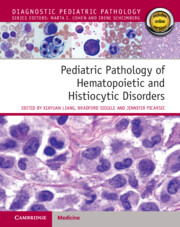Book contents
- Pediatric Pathology of Hematopoietic and Histiocytic Disorders
- Pediatric Pathology of Hematopoietic and Histiocytic Disorders
- Copyright page
- Epigraph
- Contents
- Contributors
- Section I General Hematology and Hematopathology
- Section II Non-Neoplastic Hematologic Disorders of Blood and Bone Marrow
- Section III Non-Neoplastic Disorders of Extramedullary Lymphoid Tissues
- Section IV Neoplastic Disorders of Bone Marrow
- Chapter 9 Ancillary Tests
- Chapter 10 Juvenile Myelomonocytic Leukemia (JMML)
- Chapter 11 Myeloid/Lymphoid Neoplasms with Eosinophilia and Gene Rearrangement
- Chapter 12 Myeloproliferative Neoplasms (MPNs)
- Chapter 13 Childhood Myelodysplastic Syndromes (MDSs)
- Chapter 14 Acute Myeloid Leukemia with Related Precursor Neoplasms
- Chapter 15 Myeloid Neoplasms with Germline Predisposition
- Chapter 16 Blastic Plasmacytoid Dendritic Cell Neoplasms (BPDCNs)
- Chapter 17 Acute Leukemia of Ambiguous Lineage
- Chapter 18 Precursor Lymphoid Neoplasms
- Chapter 19 Solid Tumor Metastasis to the Bone Marrow
- Section V Mature Lymphoid Neoplasms
- Section VI Histiocytic Disorders and Neoplasms
- Index
- References
Chapter 13 - Childhood Myelodysplastic Syndromes (MDSs)
from Section IV - Neoplastic Disorders of Bone Marrow
Published online by Cambridge University Press: 25 January 2024
- Pediatric Pathology of Hematopoietic and Histiocytic Disorders
- Pediatric Pathology of Hematopoietic and Histiocytic Disorders
- Copyright page
- Epigraph
- Contents
- Contributors
- Section I General Hematology and Hematopathology
- Section II Non-Neoplastic Hematologic Disorders of Blood and Bone Marrow
- Section III Non-Neoplastic Disorders of Extramedullary Lymphoid Tissues
- Section IV Neoplastic Disorders of Bone Marrow
- Chapter 9 Ancillary Tests
- Chapter 10 Juvenile Myelomonocytic Leukemia (JMML)
- Chapter 11 Myeloid/Lymphoid Neoplasms with Eosinophilia and Gene Rearrangement
- Chapter 12 Myeloproliferative Neoplasms (MPNs)
- Chapter 13 Childhood Myelodysplastic Syndromes (MDSs)
- Chapter 14 Acute Myeloid Leukemia with Related Precursor Neoplasms
- Chapter 15 Myeloid Neoplasms with Germline Predisposition
- Chapter 16 Blastic Plasmacytoid Dendritic Cell Neoplasms (BPDCNs)
- Chapter 17 Acute Leukemia of Ambiguous Lineage
- Chapter 18 Precursor Lymphoid Neoplasms
- Chapter 19 Solid Tumor Metastasis to the Bone Marrow
- Section V Mature Lymphoid Neoplasms
- Section VI Histiocytic Disorders and Neoplasms
- Index
- References
Summary
Childhood myelodysplastic syndromes (MDSs) are clonal myeloid neoplasms characterized by impaired production of circulating hematopoietic elements (generally, hemoglobin concentration < 10 g/dL, platelet count < 100 × 109/L, or absolute neutrophil count < 1.8 × 109/L), frequently accompanied by morphologic dysplasia and recurrent genetic abnormalities and lacking features of overproduction of additional hematopoietic lineage elements. In light of its rarity in comparison to its clinicopathologic mimics, minimal diagnostic criteria have been proposed (see Table 13.1).
- Type
- Chapter
- Information
- Pediatric Pathology of Hematopoietic and Histiocytic Disorders , pp. 148 - 154Publisher: Cambridge University PressPrint publication year: 2024



